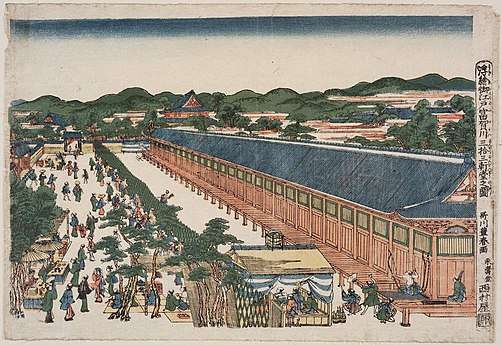Tōshiya
The Tōshiya (通し矢, とおしや, "passing arrow") or the arrows which hit the target, was an archery exhibition contest held on the west veranda of Sanjūsangen-dō temple in Kyoto, Japan.

History of the contest
The contest originated in the late 16th century[1] dating back to 1606 when a samurai named Asaoka Heibei is said to have shot 51 arrows in rapid succession down the length of the veranda.[2] In the beginning, archers shot arrows from the southern end of the veranda to the northern end where a curtain-like ornament was erected as a target. The contest gained popularity during the Edo period and by the late 17th century competitions between participants from the Owari and Kishū provinces were drawing big crowds. The Tōshiya would later be used as a motif in stories and film.
There were four distinct events at the competition:[3]
- The Hyaku-i (百射, ひゃくい, lit. one hundred shots) The archer who hit the target with the most out of 100 arrows was declared the winner.
- The Sen-i (千射, せんい, lit. one thousand shots) The archer who hit the target with the most out of 1000 arrows was declared the winner. In 1827, an 11-year-old named Kokura Gishichi successfully hit the target 995 times firing from half the distance of the hall.[4]
- The Hiyakazu (日矢数, ひやかず, lit. Number of arrows in a day) Boys who had not yet celebrated their Genpuku, or coming-of-age ceremony, could compete in this event. Archers would shoot as many arrows as possible for a 12-hour period during the day. In 1774, the third year of the An'ei era, Masaaki Noro, a 13-year-old from Kishū, shot 11,715 arrows with almost all of them hitting the target.[5]
- The Ōyakazu (大矢数, おおやかず, lit. great many arrows) This event is said to date from the Keichō era. Archers would shoot as many arrows as possible for a 24-hour period, loosing an average of 10,000 arrows. On April 26, 1686, Wasa Daihachiro from Kishū successfully shot 8,133 out of 13,053 arrows averaging 544 arrows an hour, or 9 arrows a minute, and became the record holder.[6][7]
Champions were honored by having a certificate hung in the temple showing their name, age, the number of arrows shot and the date of the competition.
The contest today
In 1861, after 255 years, the Tōshiya ceased being held, but a contest based on the Tōshiya called Oh-mato Taikai, or Festival of the Great Target still continues today, drawing roughly 2,000 participants from throughout Japan. Archers shoot arrows into targets approximately 50 - 100 centimeters in diameter and 60 meters (198 feet) away at the opposite end of the veranda. It is held on the second Sunday of January in conjunction with the temple's most important mass, the Yanagi-no-Okaji, or Rite of the Willow ritual and Japan's Coming of Age Day.[8]
References
- National Treasure Sanjūsangen-dō. Kyoto. p. 30.
- Rowthorn, Chris (2008). Lonely Planet Kyoto: City Guide. China: Lonely Planet Publications. p. 15. Retrieved 2010-02-01.
- Guttmann, Allen; Thompson, Lee Austin (2001). Japanese sports: a history. University of Hawaii Press. p. 54. ISBN 0-8248-2464-4.
- Guttmann, Allen; Thompson, Lee Austin (2001). Japanese sports: a history. University of Hawaii Press. p. 55. ISBN 0-8248-2464-4.
- Tōshiya (no date): placard at Sanjūsangen-dō, Kyoto, Japan. Viewed on 2010-02-02
- National Treasure Sanjūsangen-dō. Kyoto. p. 29.
- Turnbull, Stephen R. (2000). The Samurai Tradition. 2. Routledge. p. 258. ISBN 1-873410-22-0.
- "Historical "Toshiya" Archery Contest Held at Sanjusangen-do Young Women in Colorful Kimono also Fire Arrows". Kyoto Shimbun. 2004-01-18.